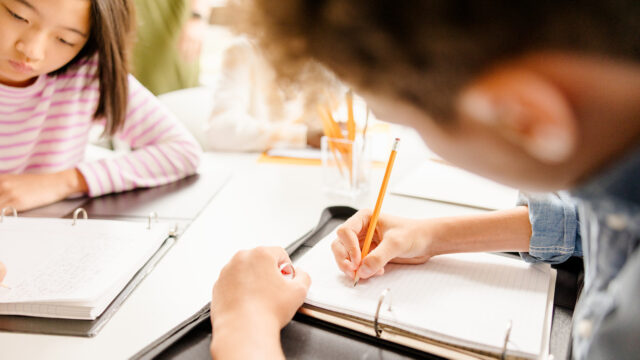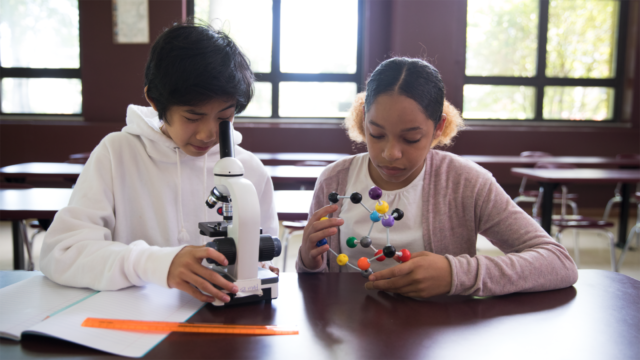
Summer Science Activities and Experiments
Keep the learning going throughout summer break with these eight fun summer science experiments and activities. These activities inspire kids to explore science—even without access to a classroom or a lab.
Activity 1: Bubbles and Art, Grades K–5
- Key Standard: Conduct an investigation to determine whether the mixing of two or more substances results in new substances.
Blowing bubbles screams summertime fun! Try making bubble solution using common household items.
What You’ll Need:
- 2 cups warm water
- 1/3 cup dish soap
- 1/4 cup corn syrup
- Bowl
- Bubble wand
What to Do:
- Explain that you’re making a simple bubble solution. The corn syrup will help the bubbles last longer.
- Mix the water, corn syrup, and dish soap in a bowl.
- Test the solution by blowing bubbles using a wand.
This activity is also a great opportunity to show how science can be used to make art. Encourage kids to change the color of their bubbles by using watercolors. They’ll need their bubble solution, watercolors, one or multiple containers, a wand, and large sheets of paper.
After adding the bubble solution to the containers, mix in the watercolors (use one color per container). Lay down a large piece of paper, and have kids create their artwork by dipping the wand in the bubble solution and blowing it onto the paper.

Activity 2: Nature Spies, Grades K–5
- Key Standard: Plan and conduct an investigation to describe and classify different kinds of materials by their observable properties.
Hiking and nature walks allow kids to develop their observational skills, and in this activity, they can focus on one particular item in nature (for example, a flower, tree, or insect) and try to remember the details about the object. Once they return home, they can write their observations using a shapebook pattern worksheet.
- What was the item’s color and size? Use the different senses you have to describe what you observed.
- Where was the item located? In a tree? By the water? In the sky?
- Was the object silent? Or did it make a noise?
- Did the object have a smell? How would you describe it?
- Did you feel the object? Was it hard or soft?
Activity 3: Ready, Set, Fly!, Grades K–8
- Key Standard: Plan and conduct an investigation to compare the effects of different strengths or different directions of pushes and pulls on the motion of an object.
- Key Standard: Plan an investigation to provide evidence that the change in an object’s motion depends on the sum of the forces on the object and the mass of the object.
Folding paper airplanes is a fun activity for any kid with access to paper. And with plenty of possible airplane designs out there, children can try their favorites and test the results. We’ve included a simple, classic dart design below. You’ll only need paper—any color will do! Afterward, help kids look online for different ways of folding the paper.
What to Do:
- Vertically fold a piece of paper in half.
- Unfold and then fold the top corners to the center crease.
- Fold the new left and right corners to the center crease.
- Fold the plane in half.
- Next, form the wings. Fold the left edge to the right. Turn the plane over and fold the other wing to line up with the other.
- Now, it’s time to test out the plane. Unfold the wings, tilt them up, hold the plane at the center, and throw it far!
Afterward, children might wonder what helps paper planes fly. Discuss with them the forces behind what makes planes fly using this resource from the Smithsonian’s National Air and Space Museum.

Activity 4: Summertime Scavenger Hunt, Grades K–5
- Key Standard: Plan and conduct an investigation to describe and classify different kinds of materials by their observable properties.
- Key Standard: Make observations of plants and animals to compare the diversity of life in different habitats.
- Key Standard: Use observations of the sun, moon, and stars to describe patterns that can be predicted.
Whether your kids spend their time outdoors in their backyard or at the park, engage them in a scavenger hunt. Start with these ideas.
Backyard or Park:
- Animals on the ground
- Animals in the air
- At least one recyclable item
- Footprints made by an animal or human
Day and Nighttime Sky:
- At least three types of clouds
- A flying object (a plane, helicopter, bird, or anything else that uses the sky to navigate)
- Any constellation
- Moon (what’s the current moon phase?)
Activity 5: Summer Sun Reading, Grade 5
- Key Standard: Support an argument that the apparent brightness of the sun and stars is due to their relative distances from the Earth.
Inspire kids to do some reading over the break by pairing a hands-on science activity with one of our leveled readers from HMH Into Science. In the activity, kids use glow sticks to determine why the sun looks brighter than the other stars in the sky. And in the leveled reader, they’ll learn how scientists study the sun, our closest star, without damaging their eyes.

Activity 6: Solar Prints, Grades K–8
- Key Standard: Construct an argument with evidence that some changes caused by heating or cooling can be reversed and some cannot.
Summertime is a perfect time to show how science is a part of learning in any subject, such as art! This science-meets-art activity was pulled from our blog “7 End-of-Year Science Activities to Celebrate the Start of Summer.” See the original blog for similar activities and ways to adjust this one for specific grade bands.
What You’ll Need:
- Blue or black sheets of construction paper or solar print paper
- Small objects (such as crayons, leaves, rocks, flowers, dice, paper clips, or feathers)
- Baking pans (optional)
What to Do:
- Hand out a piece of paper in a baking pan.
- Have children carefully arrange objects on the paper.
- Take the papers in pans outside to a sunny area.
- Wait at least three hours.
- Bring the pans inside and remove the objects.
- What happened to the paper not covered by an object?
Activity 7: Modeling Fossil Formations, Grades 6–8
- Key Standard: Analyze and interpret data from fossils to provide evidence of the organisms and the environments in which they lived long ago.
Kids might collect tiny treasures during their summertime adventures. Instead of throwing these items away, they can model fossil formation using one of the small objects.
What You’ll Need:
- Modeling dough
- Liquid glue
- Small objects (such as shells, twigs, and coins)
What to Do:
- Kids select one object to model and mold the clay into a flat, thick surface.
- Then, have kids press their object into the clay to make a detailed impression; they should then carefully remove their object without disturbing the impression.
- Have kids fill the mold formed by the clay impression with liquid glue; let the glue try.
- When the glue has dried, peel it back. The impression left is the fossil of the object.
To extend this activity, download the resource below, which provides questions that help children connect forming their fossils to the fossilization process. Additionally, if working with multiple kids, they can exchange their models with one another to identify and analyze what items made the fossils.

Activity 8: Camping Trip Inventions, Grades K–8
- Key Standard: Define a simple design problem reflecting a need or a want that includes specified criteria for success and constraints on materials, time, or cost.
- Key Standard: Generate and compare multiple possible solutions to a problem based on how well each is likely to meet the criteria and constraints of the problem.
- Key Standard: Define the criteria and constraints of a design problem with sufficient precision to ensure a successful solution, taking into account relevant scientific principles and potential impacts on people and the natural environment that may limit possible solutions.
Have kids imagine they’re heading on a camping trip. Pick one of the following problems that might occur, and have kids brainstorm a solution:
- You’ve packed plenty of food, but you want to heat some of it before eating it. Think of various ways you can heat your next meal.
- The zipper on your tent has broken. Oh no! How else could you find coverage at night?
- You’ve been lucky that there has been nothing but sunny days. But you need a break from the sun’s rays while hiking. What are ways you can find shade?
After brainstorming possible solutions, have children decide on an invention that they are going to create. They should draw their design and list all the materials they would need to build it. Facilitate a discussion around the inventions. How can they test their invention to make sure it works before building it? If working with multiple children, do they have ideas for improving one another’s inventions?
Share Your Summer Science Projects
How do you keep learning going—even when school is out? Do you use easy summer science experiments to ensure knowledge isn’t lost? Share your fun summer science activities with us via email at shaped@hmhco.com.
***
Want more quick-and-easy summer science projects? You’d love our 90-second science videos!
Learn more about HMH’s science programs, designed to encourage student-directed learning and open students’ minds to a world of scientific thinking.
Be the first to read the latest from Shaped.















